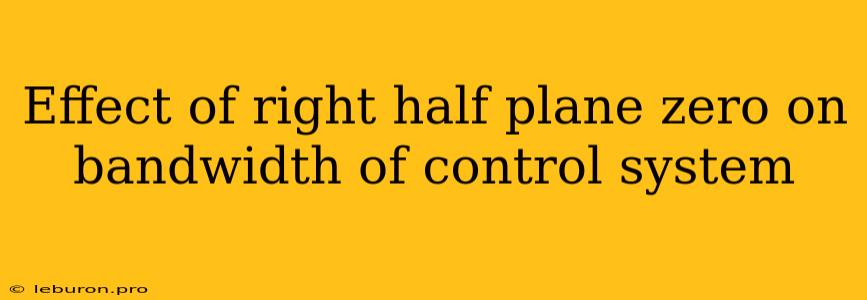The presence of a right half plane zero (RHP zero) in a control system's transfer function can significantly impact its bandwidth, often leading to limitations in performance. This article delves into the intricacies of RHP zeros, exploring their origins, their impact on system behavior, and practical strategies for mitigating their adverse effects on bandwidth. Understanding the influence of RHP zeros is crucial for designing robust control systems that achieve desired performance goals while maintaining stability.
Understanding Right Half Plane Zeros
A right half plane zero (RHP zero) is a zero of the transfer function of a control system located in the right half of the complex s-plane. In contrast to left half plane zeros, which contribute to stability and faster settling times, RHP zeros introduce undesirable characteristics, particularly limiting the achievable bandwidth.
Origin of Right Half Plane Zeros
RHP zeros typically arise due to inherent dynamics within the controlled process or the feedback loop. Common sources include:
- Time Delays: Delays in signal transmission or processing often introduce RHP zeros. For instance, in a chemical process where the reaction time is significant, or in a networked control system with communication latency, time delays can result in RHP zeros.
- Non-minimum Phase Systems: Systems exhibiting non-minimum phase behavior, characterized by an inverse response, often contain RHP zeros. This arises when a system initially responds in the opposite direction to the desired output before settling to the desired value. For example, in a heating system, the temperature may initially decrease before rising to the setpoint due to the time taken for the heating element to reach its operating temperature.
- Feedback Loop Dynamics: Complex feedback control schemes can also lead to the introduction of RHP zeros. These can occur when the feedback signal is delayed or filtered in a manner that creates a non-minimum phase response.
Impact of Right Half Plane Zeros on Bandwidth
Bandwidth Limitations: The most significant impact of RHP zeros is the restriction of bandwidth. Bandwidth represents the range of frequencies the system can effectively handle. With an RHP zero, the system's response rolls off rapidly beyond a certain frequency, limiting the system's ability to track fast changes in the input signal.
Phase Lag: RHP zeros introduce significant phase lag in the system's response. This phase lag can lead to instability, particularly as the system approaches its bandwidth limit. The phase lag associated with RHP zeros can cause the system to oscillate or even become unstable if the gain is not carefully controlled.
Undershoot and Overshoot: RHP zeros often result in undershoot and overshoot in the system's response. This occurs because the system initially responds in the wrong direction due to the non-minimum phase behavior associated with RHP zeros.
Slower Settling Time: The presence of RHP zeros generally leads to a slower settling time for the system. This is because the system's response is delayed and may oscillate before settling to its final value.
Strategies for Mitigating the Impact of RHP Zeros
Several approaches can be adopted to mitigate the adverse effects of RHP zeros on system bandwidth and performance:
1. System Redesign:
- Minimizing Time Delays: Reducing time delays in the system, either by improving communication infrastructure or by optimizing process parameters, can effectively eliminate or reduce the influence of RHP zeros.
- Modifying Feedback Loop Dynamics: Careful redesign of the feedback loop to minimize phase lag and eliminate non-minimum phase elements can effectively address RHP zero issues.
2. Control Design Techniques:
- Lead Compensation: Lead compensators can be employed to introduce phase lead in the system's response, thereby counteracting the phase lag introduced by the RHP zero.
- Feedforward Control: Utilizing feedforward control can compensate for the non-minimum phase behavior associated with RHP zeros by predicting and canceling the initial inverse response.
- Robust Control Design: Robust control techniques, such as H-infinity control, aim to design controllers that are insensitive to uncertainties, including the presence of RHP zeros.
3. Model-Based Compensation:
- Zero Placement Techniques: By introducing artificial zeros into the system's transfer function, it's possible to effectively cancel or minimize the impact of the RHP zero. These techniques require a good understanding of the system's dynamics and can be implemented using adaptive control algorithms.
Conclusion
Right half plane zeros present a significant challenge to the design and performance of control systems, imposing limitations on bandwidth and introducing undesired behavior. Understanding the sources and impact of RHP zeros is crucial for designing stable and high-performance systems. Through careful system design, appropriate control techniques, and model-based compensation methods, it is possible to mitigate the negative effects of RHP zeros and achieve desired bandwidth and performance characteristics. By carefully addressing RHP zeros during the design phase, engineers can ensure that control systems operate reliably and effectively in the presence of these challenging dynamics.
